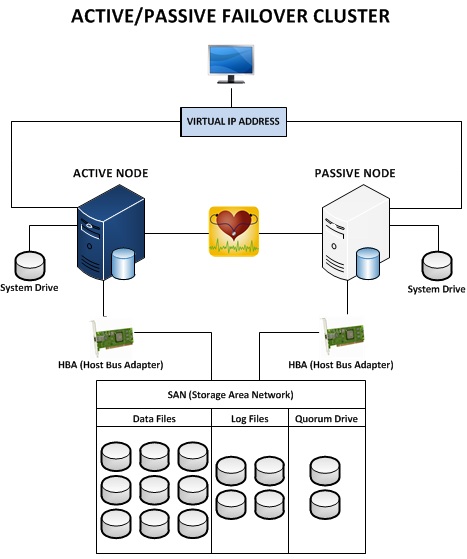SQL Server 2008 R2 High Availability Options for Temenos T24 - Part 1 of 4: Failover Clustering
SQL Server 2008 R2 Enterprise and Data Center editions comes standard with a number of high availability options. Temenos' T24 application can make use of many of these options depending on the customer's tolerance for downtime and data loss. In a T24 implementation, SQL Server is typically installed in a two-node failover cluster to provide an alternate server for the database. This protects the system from the failure of server components such as the network adapters, the processors, or the SAN connectivity.

The above diagram shows a 2 node Active/Passive failover cluster. In a 2 node Active/Passive failover cluster topology one node owns the services (active), the other remains inoperative (passive). Should the active node fail, the passive or backup node takes the resources and reactivates the services, while the ex-active node remains in turn inoperative. Typically, the data resides on a SAN with disks configured as RAID 10 (recommended) or RAID 5, providing redundancy for the LUNs used by SQL Server. The SAN is connected to the servers via two or more HBAs. The time to detect a fault and switch to the alternate node is typically less than one minute. (Note that the time is dependent on the current transactional load and on the configuration, such as the number of drives or other resources in the resource group.)
The 2 node failover cluster topology can also be used for planned maintenance. With SQL Server 2008, you can apply service packs to inactive nodes, and then you can fail the active SQL Server group over to the patched nodes. (Note that this results in a brief usage outage.) For more information on applying service packs to a failover cluster instance, see SQL Server 2008 Failover Cluster Rolling Patch and Service Pack Process.
NOTE: Setup operations for SQL Server failover clustering have changed in SQL Server 2008 R2. To install or upgrade a SQL Server failover cluster, you must run the Setup program on each node of the failover cluster. To add a node to an existing SQL Server failover cluster, you must run SQL Server Setup on the node that is to be added to the SQL Server failover cluster instance. Do not run Setup on the active node to manage the other nodes. Please review Creating a New SQL Failover Cluster article on MSDN.
Stay Tuned for future blog posts on other High Availability options for Temenos T24
Please review the Best Practices for Running TEMENOS T24 on Microsoft SQL Server and Windows Server whitepaper for more information.